Technologies
Google Pixel Tablet Review: Android Tablets Are Back
Google’s fast tablet is also a dockable home hub. Will Google commit to its tablet vision this time?
The world of Android tablets has been a weirdly up-and-down ride for the last decade or so. I remember Google’s fantastic little 7-inch Nexus tablet back in 2012. And Google’s considerably less successful Chromebook-meets-Android Pixel Slate, a sort of touchscreen laptop/tablet hybrid. That was Google’s previous tablet hardware entry.
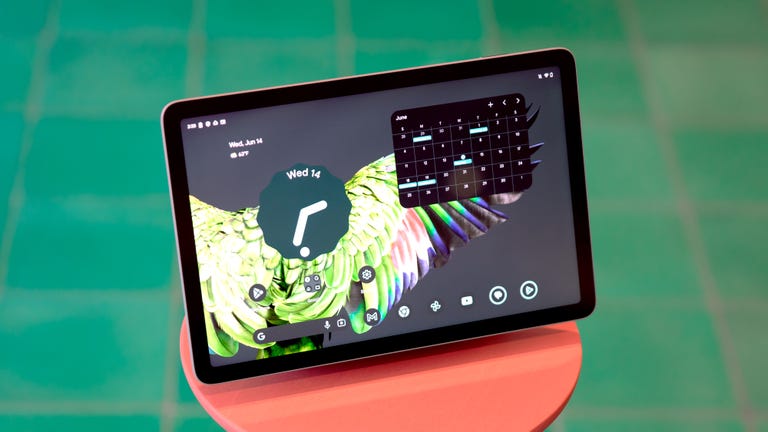
06:35
The Pixel Tablet is a return to Android tablets for Google. But its competition never strayed. Samsung’s ongoing tablet series, for instance, and Amazon’s Fire tablets (which can sideload the Google Play store and are very affordable). Google’s new Pixel Tablet is hopefully a return to excellent Android tablet software and features, too: The $500 Pixel Tablet feels like a really good iPad alternative for Google ecosystem people. Google also took a unique approach by making it a dockable home hub, something Apple should steal someday for its iPad lineup.
Google Pixel Tablet
Like
- Fast processor
- Included speaker dock sounds great
- Good front video camera
Don’t like
- Price ramps up for cases and more storage
- No keyboard or stylus case options
There are only two gripes I have: this Pixel Tablet, while fast-performing and really nicely built, doesn’t have a Google keyboard case at launch, nor any stylus option. This is more of a sharable tablet for the home and family than a get-work-done tablet, although you could absolutely bring your own accessories and make it what you want.
At $500, this Pixel isn’t a budget tablet and if you want to add more storage beyond the base model’s 128GB, the 256GB version is $100 more. Add another $80 for Google’s Pixel Tablet protective case. It’s a more expensive package than Apple’s entry-level iPad. But, if you’re looking for a more premium Android tablet for families than Amazon’s Fire options or Samsung’s Tab A-series, this looks like the best bet.
Read more: Best Android Tablets of 2023
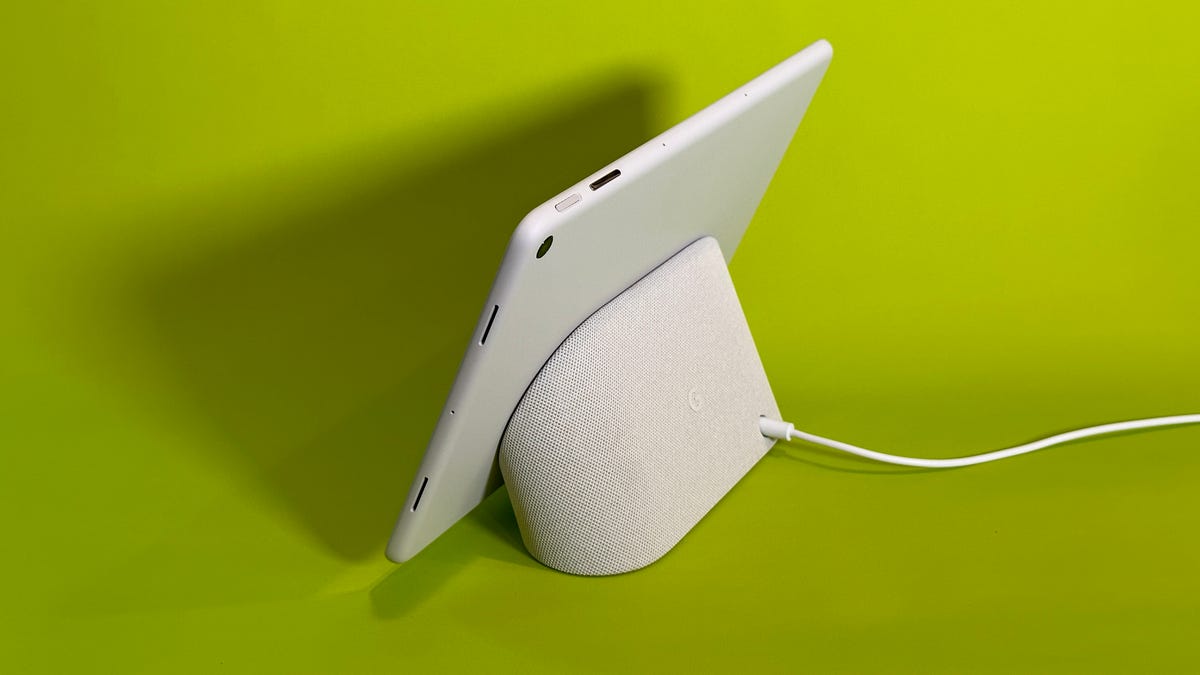
The tablet snaps into its charge dock, which doubles as a speaker.
Design: Clean and comfy
Google’s Pixel Tablet has an iPad-like feel, with a nearly 11-inch display and a smooth aluminum case. At a bit over a pound, it’s comfortable enough to hold but leans toward the heavier side with its case on.
The screen resolution — 2,560×1,600 pixels — gives you a crisp picture, and bright, too. The side speakers are good enough on their own but not as great as what the speaker dock provides (as you might expect).
There’s no headphone jack, so you’ll need USB-C headphones or an adapter, or go Bluetooth. There is a fast-acting fingerprint sensor in the power button that unlocks the Pixel Tablet as fast as a Pixel phone. Overall, it’s what I’d want from a tablet, and it looks really good when docked. The whole design ends up feeling like a larger Google Nest Hub, or a smart picture frame.
Google’s expensive case (there are also less-expensive third-party options) is pretty great, too, with a soft finish and protective edges, and a metal, ringlike kickstand that adjusts to any angle and still docks in the speaker hub. It’s not a keyboard case, but you could add your own Bluetooth keyboard for desk typing.
The dock is great
Google includes a dock the Pixel Tablet magnetically attaches to that charges and acts as a stand so that the tablet can be a home picture frame, or smart home interface, or a connected speaker/display with YouTube benefits or whatever else you might need. The speaker-equipped dock has a fabric covering much like Google’s other home products and is small enough to pack easily for travel. Its speakers sound boomy for playing music indoors, too.
Snapping the tablet on and off the dock is relatively easy, although sometimes it’s a little hard to locate the magnetic pins, and pulling the tablet off the dock can sometimes result in pulling the lightweight dock with it. The dock charge plug and cable are also proprietary, not USB-C. The Pixel Tablet does have a USB-C port for charging, but you’ll need that specific dock cable to plug it into your home, and the cable length isn’t exactly long.
The Pixel Tablet supports casting audio from another device to the tablet when it’s connected, but the speaker dock won’t work when the Tablet isn’t mounted on it and has no Bluetooth. That’s a bit of a bummer if someone wants to use the speaker while someone else uses the tablet.
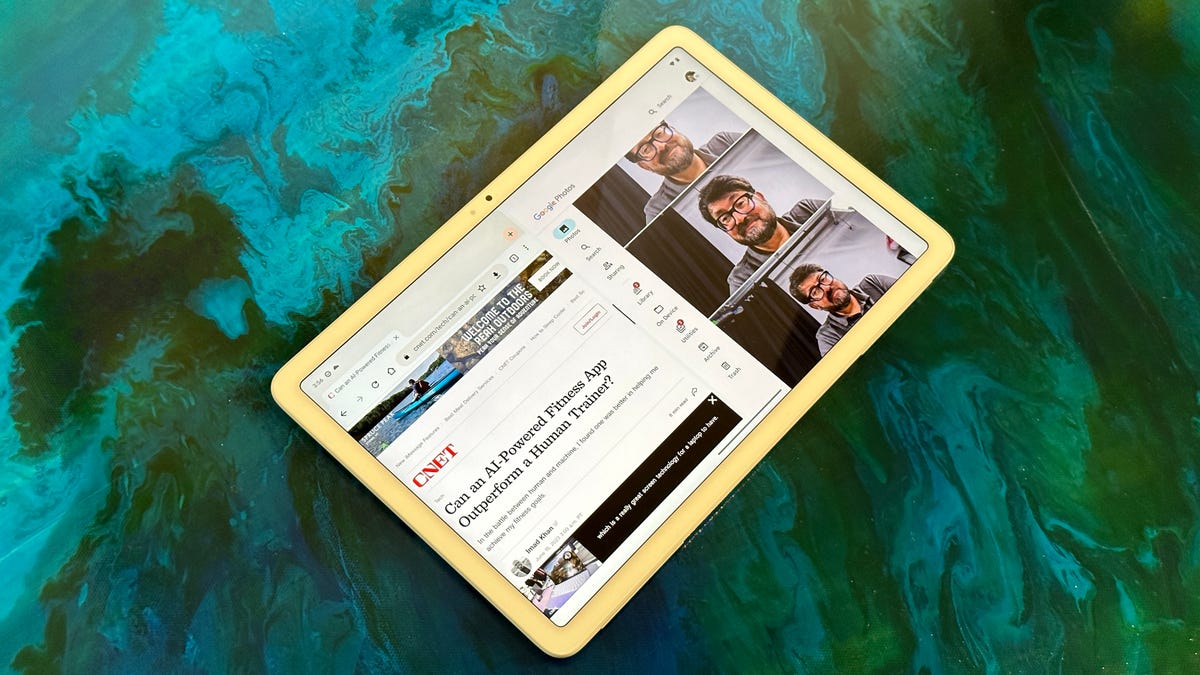
Split-screen multitasking is just fine on this tablet, and a bunch of apps already support it.
Performance and software: Speedy and improved, mostly
The Google Tensor G2 chip, similar to what’s on the most recent Pixel phones, is zippy in the tablet and generally runs well. There were a few moments where apps seemed to glitch a bit in split-screen multitasking, but that could also be due to this being a prerelease device running early software.
Google’s renewed attention to tablet software shows, with multitasking that feels like Apple’s iPadOS; apps can be easily dragged up from an app taskbar into another window, and two apps at once can be adjusted to fit on a few preset-size settings. Google’s also added a series of widgets that help customize information, which I sometimes found useful and at other times thought weren’t flexible enough.
Videos from another app, like YouTube, can pop up and hover in a small window over these split windows, too. It feels great to work in these modes, although not all apps work for the Pixel Tablet yet. Google focused on optimizing a bunch of popular apps and also its own core apps first, but hopefully more will come. There are also some Google Play apps that don’t run at all yet on Pixel Tablet, including Geekbench, which we use for testing tablets for performance comparisons.
The Tensor G2 pulls off some tricks Google has on its Pixel phones, too, notably Magic Eraser in the Photos app, which removes people or objects from shots. Dictation also works really well: I could see myself voice-typing a lot with the Pixel Tablet, even if I still miss a dedicated keyboard case (hint, hint). Google’s on-screen keyboard is fine, but I didn’t fall in love with it. I also found that a few multifinger swipe gestures got a little weird at times in apps like Google Earth. Some two-finger swipes and pinches, for instance, were not always recognized, but maybe a future software update can address that.
Nice camera
The front-facing 8-megapixel camera looked good for selfies and video chat, and looked sharper than my normal laptop-video-chat expectations. Google placed its camera on the long edge where it should be, much like Apple’s most recent 10th-gen iPad. It means this tablet can be used easily for video chat when docked. But, a subject-tracking, autoframing feature didn’t seem to work on my review unit, and video quality looked better for the moment with Google Meet than in Zoom.
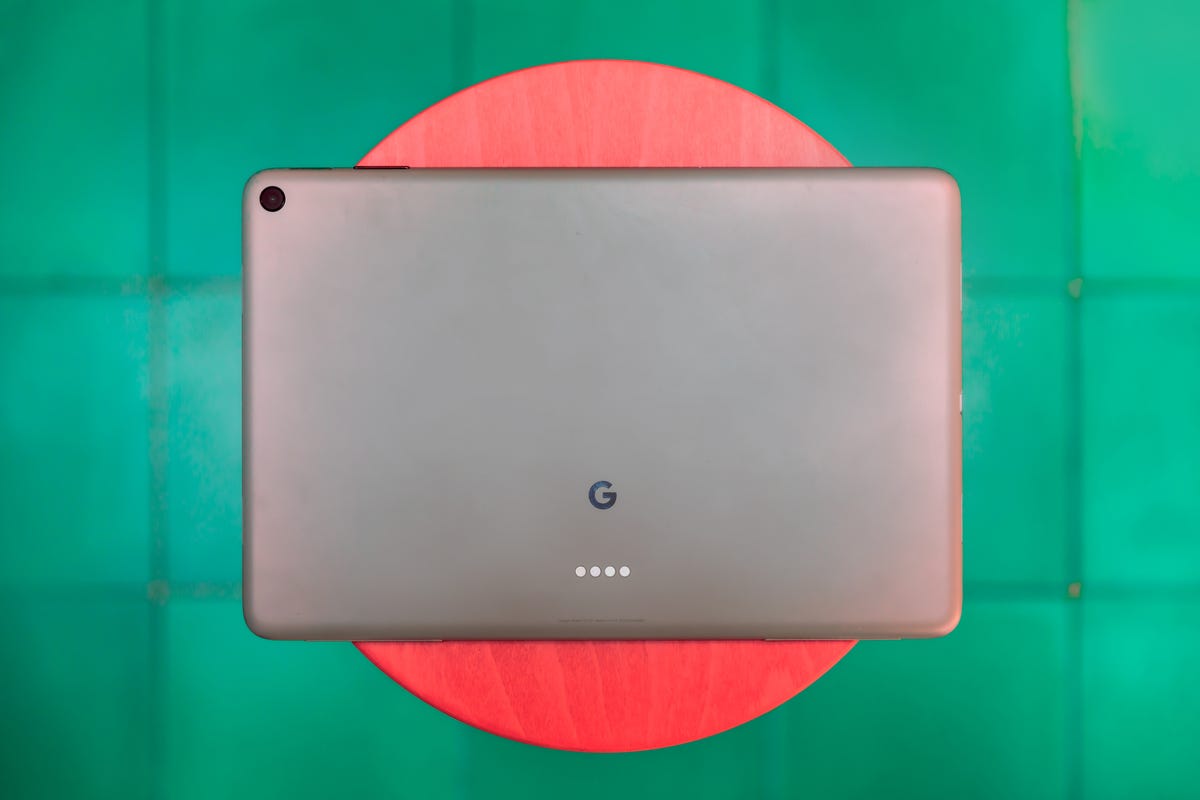
Google makes extra accounts pretty easy
One other advantage of Google tablets over iPads is account-swapping. Much like a Chromebook, you can add extra accounts and switch over to others easily enough here, even entering a guest mode or a kid mode. This underlines the family-sharing concept that’s at this tablet’s core, and I like it. I could easily see the Pixel Tablet being a casual grab-a-tablet option in a living room where someone could just pick it up as needed and check a few things, watch a video or play a game.
I miss Google’s work focus on the Slate, though
I miss some of the ideas Google was going for on its previous Slate tablet, which was more of a Chromebook with Android benefits. The Pixel Slate made a keyboard and trackpad one of its big included features. This time, the Android-focused Pixel Tablet has gone the other way, toward a sharable, video-and-game-playing, app-browsing tablet, but without any great ideas for how to add a keyboard or access to ChromeOS-type features in a new, helpful way. Anyone who wants a Chromebook will still want to get a Chromebook — or a laptop. You could add a keyboard here, or a stylus, but your mileage won’t be any different than on another Android tablet. Plus, with other options from Samsung, OnePlus and Amazon, keyboard accessories are already there — or even included.

There’s a USB-C port on the Pixel Tablet, even though the dock charges with its own proprietary plug and pin connector.
Yes, it could be a home hub, too
I didn’t test the smart home features of this tablet, but you can connect Google Home devices and services just like you’d do on a Nest Hub. That’s the Pixel Tablet’s greatest success as a device, and where Google pivoted this time with its design. Voice response via its microphones was fast, and I was able to play music, ask questions, play audiobooks and launch YouTube videos quickly with voice commands. Once my kids realized this thing could play videos, they gathered around it like a small TV. It could be a great kitchen option, especially since the tablet hovers when in the dock (avoiding contact with counter surfaces). The dock angle won’t adjust beyond its slightly elevated angle, but I found it easy enough to glance at when on a table or counter.
A great start for Google’s return to tablets
Don’t stop, Google: Keep building off the Pixel Tablet, add a keyboard case, and maybe lower the price a bit (with a case and the 256GB storage option, which costs an extra $100, you’re suddenly pushing towards $700). But this is the Google tablet you’re probably looking for, despite the price. The only question is whether Google commits to its software and performance over time. Google tends to suddenly change focus on product lines, especially its tablets. But the Pixel Tablet is a great addition to its device lineup and a perfect nonphone option. Keep it around, please.
Technologies
Today’s NYT Connections: Sports Edition Hints and Answers for Nov. 28, #431
Here are hints and the answers for the NYT Connections: Sports Edition puzzle for Nov. 28, No. 431.
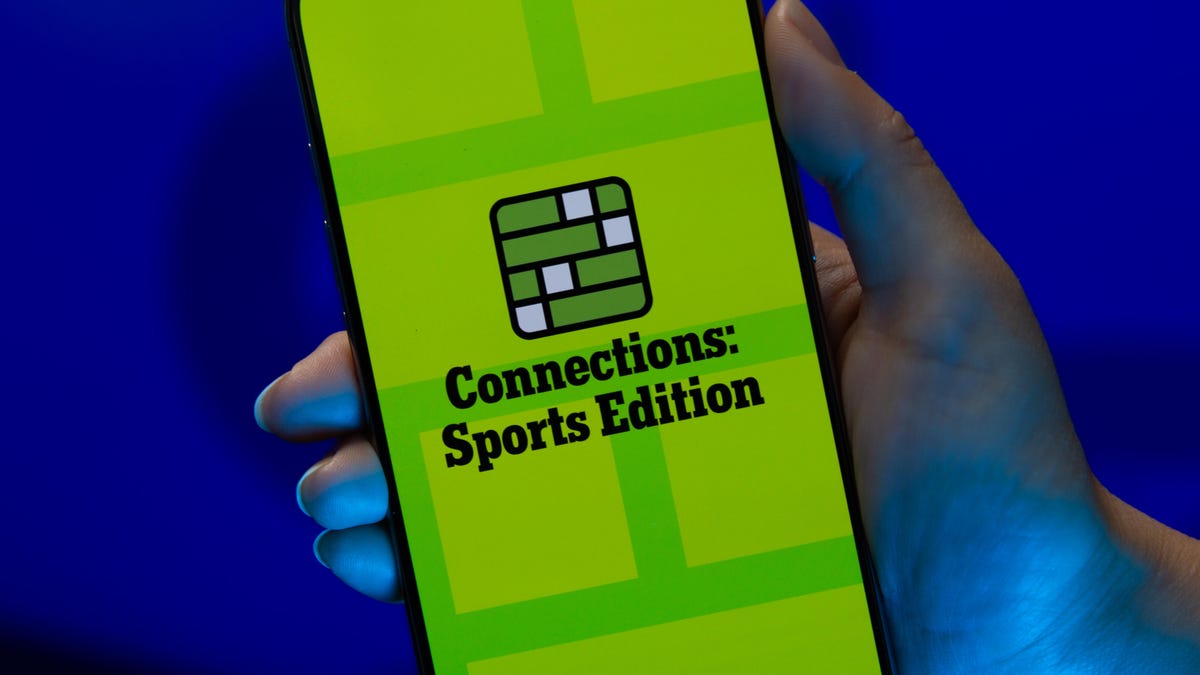
Looking for the most recent regular Connections answers? Click here for today’s Connections hints, as well as our daily answers and hints for The New York Times Mini Crossword, Wordle and Strands puzzles.
Today’s Connections: Sports Edition is a pretty tough one. If you’re struggling with today’s puzzle but still want to solve it, read on for hints and the answers.
Connections: Sports Edition is published by The Athletic, the subscription-based sports journalism site owned by The Times. It doesn’t appear in the NYT Games app, but it does in The Athletic’s own app. Or you can play it for free online.
Read more: NYT Connections: Sports Edition Puzzle Comes Out of Beta
Hints for today’s Connections: Sports Edition groups
Here are four hints for the groupings in today’s Connections: Sports Edition puzzle, ranked from the easiest yellow group to the tough (and sometimes bizarre) purple group.
Yellow group hint: Shoes.
Green group hint: Think Olympics.
Blue group hint: Kick the ball.
Purple group hint: Family affair.
Answers for today’s Connections: Sports Edition groups
Yellow group: Basketball sneaker brands.
Green group: First words of gymnastics apparatus.
Blue group: Women’s soccer stars.
Purple group: Basketball father/son combos.
Read more: Wordle Cheat Sheet: Here Are the Most Popular Letters Used in English Words
What are today’s Connections: Sports Edition answers?
The yellow words in today’s Connections
The theme is basketball sneaker brands. The four answers are Adidas, Jordan, Nike and Under Armour.
The green words in today’s Connections
The theme is first words of gymnastics apparatus. The four answers are balance, parallel, pommel and uneven.
The blue words in today’s Connections
The theme is women’s soccer stars. The four answers are Bonmatí, Girma, Marta and Rodman.
The purple words in today’s Connections
The theme is basketball father/son combos. The four answers are Barry, James, Pippen and Sabonis.
Technologies
I Love Using My Phone to Shoot Stunning Holiday Videos. Here’s How You Can, Too
These are my best tips for creating magical movies this festive season that you’ll cherish for years to come.
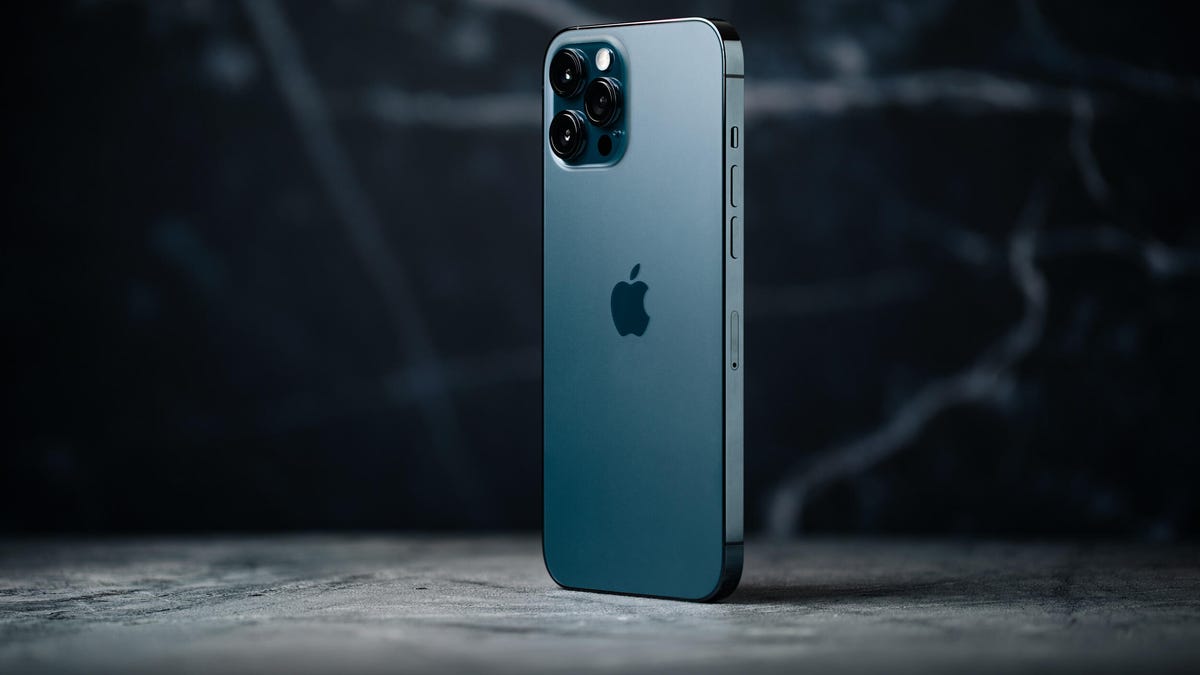
The iPhone 17 Pro is a superb video camera thanks to its glorious image quality, while its ease of use means it’s dead simple to quickly start shooting away. Then there’s the always fun 4K slow motion mode. Advances in mobile phone cameras mean It’s never been easier to shoot gorgeous footage of your family or your friends and the holidays are the perfect time to get creative with your videos. Don’t have an iPhone? Not to worry — other phones like the Samsung Galaxy S25 Ultra, Pixel 10 Pro or older iPhones and Android phones are also capable of capturing professional-looking video with very little effort on your part. But if you want to add some Hollywood flair to your videos, there’s a lot you can do to take things to the next level.
Read more: Best Camera Phones to Buy Right Now
It takes more than just a good camera to create videos you’ll want to watch again and again. You also need to know how to use that camera properly, how to capture the right moments and what makes for a good-looking shot. A creative eye and some planning will help too, taking you from a simple home video into something more inspiring that you’ll want to share with your family and watch again in years to come.
Don’t miss any of our unbiased tech content and lab-based reviews. Add CNET as a preferred Google source.
Here are my top tips that you should keep in mind when making your own family movies, whether you’re gathering for a holiday feast, journeying off to exotic lands on vacation or simply having some backyard drinks with friends.
1. Consider what you want your video to be
Before you start, you should give a bit of thought to what you want your video to include. While it could just be a full film of everything that happens over the holidays, or your child’s upcoming birthday, consider making it a bit more specific. Perhaps a video all about the games you play together, or them opening their presents.
Having a more focused story to tell — even a basic one — will help you consider what shots you’ll need to get, and it’ll help you shoot and edit only what you need, rather than having endless hours of footage to sift through. A Christmas day movie can be more straightforward as you’ll likely want to simply tell the story from the morning through to the drinking and games at the end of the day. Even so, try and consider how you can be selective and tell an interesting story rather than just filming every minute of the day you have together.
For my own festive-themed video (embedded above), I decided to show how I make my own hot mulled cider. By keeping it to a specific topic I was able to determine exactly the shots I needed and in what order, and even sketched out a storyboard of shots ahead of time. You don’t have to go that far, but having a rough idea in mind will help a great deal.
2. Set up your phone properly
Almost all recent smartphones can take great video, but it’s worth checking out the settings to make sure you’re ready to go. Your resolution settings are up to you, but full HD (1080p) is probably a good starting point, as it’ll look good but won’t fill up your phone’s storage too quickly. You can ramp it up to 4K if your phone allows it, or even drop it to 720p if you’re on an older device that won’t handle editing as well.
Read more: Best Camera Accessories for Your Phone
If you have an iPhone 14 Pro or later and plan on doing a lot of post-production on your footage in software like Adobe Premiere or DaVinci Resolve, you can consider shooting in Apple’s ProRes format. This gives you the best image quality, but the file sizes are immense, so if you want to keep things simple then it’s better to shoot in the standard video mode.
If you have the latest iPhone 17 Pro or previous iPhone 16 Pro you could take things further and shoot in Log. Log is a color profile that looks very low-contrast out of camera, but gives much more flexibility for adjusting the contrast, colors and overall look of the footage in post. Applying these edits is a process called color grading and it’s often what separates professional, Hollywood movies from everyday home videos. If you want to create a truly cinematic, professional look to your video, then shoot in Log and color grade your footage in DaVinci Resolve on your desktop or iPad.
It’s worth keeping an eye on your storage though, especially if you’re away from home for a while; you don’t want to fill up your space on the first two days of your trip only to have no room to capture the rest of the vacation. Those of you shooting ProRes Log on your iPhone 15, 16 or 17 Pro can now attach an SSD using USB-C for saving those huge files directly to external storage.
3. Keep your video clips short and sweet
While it’s easy to stand and film a five-minute clip of someone peeling potatoes for dinner, the reality is that when you watch that back, you’ll realize it’s way too long to remain interesting. Instead, consider keeping each clip to around 15-20 seconds in length. You might be surprised at how long 15 seconds of video actually seems like when you watch it back, and having lots of shorter clips cut together will give the video a more engaging, more professional feel.
If you’re walking up through a beautiful mountain trail, consider shooting 20 seconds of footage at 5- or 10-minute intervals — or only at particularly scenic viewpoints — rather than just filming the whole way up. But make sure you’re ready to capture interesting or funny moments as they happen as it’s these personal moments that you’ll enjoy looking back on down the line.
4. Stabilize your phone
There’s nothing that can ruin a video quite as easily as shaky hand-held footage. If your phone has a stabilized video mode, make sure it’s turned on. If not, consider using a small tripod to keep your phone steady. This of course also allows you, the filmmaker, to be involved in the action as well, which is great if you’re the one doing the cooking, or handing out presents.
You could even consider carrying a small mobile gimbal like the DJI OM 5. It allows you to get rock-steady footage even as you’re walking along, while the built-in selfie stick lets you film yourself more easily or capture more interesting angles for your footage than if you were just hand-holding your phone. If you’re interested in taking your mobile movie-making a bit more seriously then check out some of the best accessories you can pair with your phone to improve your footage.
5. Get creative with angles
A great way to improve the cinematic qualities in your film is to experiment with different angles. Say you’re capturing the moment your child takes a present from under the tree at Christmas — don’t just film them from your standing position nearby, but instead consider how you can capture that moment in a more exciting way. Perhaps even put the phone inside the tree, among the presents, so you see your child reaching toward the camera to retrieve their gift.
There’s no end to the ways you can play with your angles, so have a think about how you can shake things up. You can always try to reshoot certain things from multiple angles (or set up a spare phone or camera for another angle) and then cut them together in your video editor afterwards. In my video, for example, I wanted to show the cinnamon and ginger being thrown into the pot, so I used two angles: one from a first-person perspective looking into the pot, and another where I’d positioned my phone behind the pot to show me throwing the ingredients in. It’s little elements like this that can make a big difference overall.
6. Improve the audio and lighting
If your video will include people talking to the camera — perhaps your friends telling the camera where you are in the world or explaining how badly they’ll need a beer after the long hike — you’ll want to make sure your phone can capture that audio clearly. For the best results, consider buying a small external microphone like the Rode VideoMicro, which plugs into your phone’s power port, via an adapter, and will dramatically improve the sound quality.
Read more: Best Accessories for Better Video
If you don’t want to invest in extra gear there’s still a lot you can do to help. Turning off or at least lowering background music or closing the doors to drown out kitchen appliances will make a huge difference in how clear those voices can be captured. Outdoors, your biggest enemy for good audio will be the wind. There’s not always much you can do about it but at least trying to turn your back to the wind and providing a buffer between it and your phone will go some way to minimizing the problem.
Lighting is crucial too, and if you’re filming indoors in dimly lit spaces, then adding in your own light well help keep your footage looking good. I’ve outlined various LED light sources in my guide to video accessories, but one of my favorites for video production is the Zhiyun Fiveray FR100C light stick, which is easily hand-held and can produce any color you want, making it easy to get creative.
7. Experiment with slow motion and time lapses
Most recent phones have modes for taking slow motion video and for time lapses and both can be great tools for your video. Of course, it needs to make sense to use them — slow motion to slow down fast-paced action, and time lapse to speed up a long sequence.
In my mulled cider video, I used slow motion when lighting the stove to give a cinematic quality to the flames erupting, and I also slowed down the footage of me throwing ginger into the pot to get a great slow-mo effect on the cider splashing up. As it’s a short sequence it didn’t make a lot of sense to do a time lapse, but if you want to capture the whole process of making dinner, for example, a time lapse from high up in your kitchen, videoing you moving around over maybe a couple of hours would be a neat addition to a holiday film.
8. Edit your video
Once you have your video clips it’s time to piece them together. This can be the most challenging part, especially for those of you who are totally new to video production. Thankfully, there are easy ways of doing things.
Some phones, like the iPhones, as well as recent Samsung Galaxy phones, have built-in auto video makers that allow you to select some clips and automatically cut them together into a film, complete with background music and transitions between clips. They’re not always the most elegant of productions, but they’re worth keeping in mind if you’re a total beginner and just want a basic video put together to send to your family or friends.
Alternatively, look towards apps like BlackMagic’s DaVinci Resolve, which is free on the iPad (as well as on Mac or PC), with only some advanced features requiring a paid upgrade. It’s an incredibly well-rounded video editor that’s used by creative pros around the world and is renowned for its great tools for editing colors. For a more basic approach, look towards Quik by GoPro. It’s free and also lets you drop multiple video clips into a project for the app to automatically turn into a finished film. iPhone users will also be able to use Apple’s iMovie for free, which is an extremely easy-to-use video editor, with a variety of presets and styles available. Adobe Premiere Rush has a wide variety of editing tools and is built to be mobile friendly. It’s a great app, but it does cost $10 (£9, AU$15) a month, so it’s only worth considering if you think you’ll want to do more video production.
Technologies
I Replaced My iPhone Battery Myself at Home and You Can Too
You can DIY your own phone battery replacement and save a ton of money in the process. Here’s how.
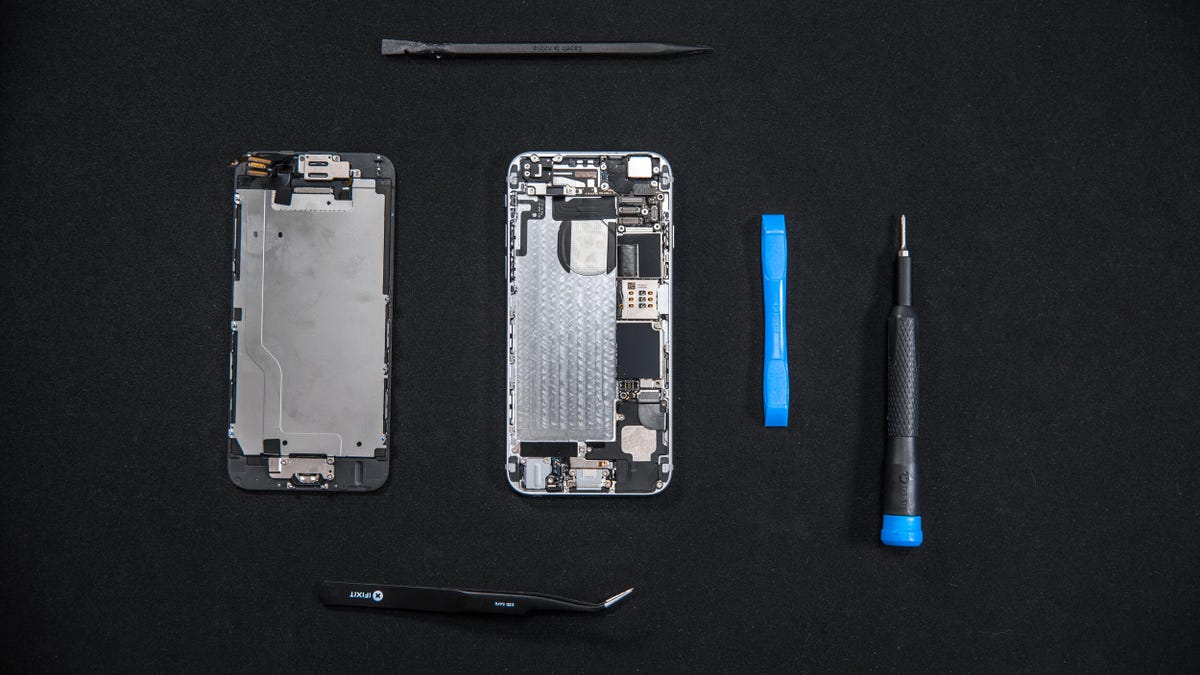
If you’ve got an iPhone 17, a Google Pixel 10 Pro or a Galaxy S25 Ultra, you won’t need to worry about the age of your battery for at least a few years. But batteries do age over time so if you have a much older iPhone or an old Android phone, you may well find that your battery no longer gives you the same battery life it did when it was new. But having an old, worn-out battery doesn’t mean buying an altogether new phone; it’s surprisingly simple to just replace the battery.
Apple has its own do-it-yourself repair program, but even if you don’t use that, you can replace your iPhone’s battery yourself at home. With affordable third-party components and various tools available to buy, you can open up your iPhone and swap out that old, worn out battery — or replace a broken screen — often for less money than having a company do it for you.
I did exactly that, replacing the old battery of a well-used iPhone 6 to give it a new lease on life. I was pleased to find the phone on eBay for only £75 (about $100 or AU$140) back in 2020. That’s a lot less than a new iPhone 17 Pro, but unfortunately the battery had aged to the point where the software had to artificially throttle the performance to stop it from shutting down. Instead of casting off the phone and getting buyer’s remorse, I decided to purchase a replacement battery and tools from iFixit and have a go at changing out the battery myself.
It took a little over an hour, but I was able to safely swap out the battery and get the iPhone 6 running perfectly again. I’m not giving step-by-step instructions here — head to iFixit and grab a kit if that’s what you’re after — but I do want to describe my experience, including how easy the process was, and hopefully answer some of the questions you may have if you also need a new battery.
If you have a more recent model (an iPhone 12 or newer), then make sure to first check Apple’s new repair options and see if you’d be able to put in a replacement with parts directly from the company.
Note that any maintenance you do on your own devices is entirely at your own risk.
To get more about iPhones, check out everything Apple announced at WWDC 2025.
1. Why would you need to replace an iPhone battery?
Batteries age over time, and considering that the iPhone 6 was released years ago, it’s no surprise that the one I bought wasn’t running in prime condition. One time, the phone unexpectedly restarted while in use, and it flashed a warning that read, «This iPhone has experienced an unexpected shutdown because the battery was unable to deliver the necessary peak power. Performance management has been applied to help prevent this from happening again.» Even the phone itself knew it had a bum battery.
In short, a phone’s performance can be throttled if it can no longer cope with power demands. There is the option to turn throttling off, but this will result in more frequent crashes. Neither situation is ideal, so a battery replacement seemed like a smart way forward for me, since it wasn’t my main phone and I was willing to take the risks.
2. How much does a replacement iPhone battery cost?
The problem with my situation specifically was that I bought the phone for so little in the first place that spending more money on a battery replacement service negated some of those initial savings. Apple’s replacement service costs £49 ($49), which is more than half what I paid for the iPhone 6 I bought. As I was in the middle of a coronavirus lockdown when I attempted this, I wasn’t able to get to an Apple store to take it in, and sending it in through the mail would bring the total cost to around £56 (about $75 or AU$105).
iFixit, however, sells a DIY replacement pack for £35 (including postage to my home in Scotland). It costs $30 in the US, and with shipping costs that comes to about $38. It’s not a huge saving over Apple’s replacement, but every little bit helps. It also means you will still have the tools you need should you want to do this again in the future. All you’d need to buy next time is the battery.
3. What comes in the iFixit battery fix kit?
iFixit’s kit comes with a third-party replacement battery that is not from Apple, since Apple does not sell its parts separately for phones older than the iPhone 12. It also has all the tools needed to open the phone and remove the old battery. The only additional thing I needed was a hair dryer to heat up and remove the glue.
4. Does replacing a battery void your phone warranty?
Opening up an iPhone will void the warranty, but if your battery is old enough to need replacing, odds are you’re already out of the 12-month warranty period.
5. Is it safe to replace your iPhone battery yourself?
This one isn’t so straightforward to answer. iFixit’s guide gives very detailed instructions on the steps involved, but there were a couple of points that made me nervous. One step involved heating up the back of the phone with a hair dryer in order to loosen the glue holding the old battery in place.
Specifically, it said to heat it to «slightly too warm to touch comfortably,» which I found a little vague. Especially since that section also warned that «overheating the iPhone may ignite the battery.» But how hot is too hot? What signs would I see if it was overheating? I couldn’t find this information, and as such wasn’t sure how close to overheating it I might be.
Shortly after, while trying to pry out the old battery, I accidentally ripped into what looked like the black wrapping around that battery. I was pretty sure that the battery itself wasn’t punctured — there was no smoke or hissing — but I’d have felt a lot more comfortable if I had «emergency» instructions on hand about what to look out for and what to do if the battery did ignite.
6. Can I replace my iPhone battery myself?
Up to a point I found I could, and I’m not the best at DIY. iFixit’s instructions were easy to follow, and there were only seven internal screws to remove, which were easy to then put back.
One thing I found confusing was that the instructions on iFixit’s website end at the point where you remove the old battery. The only instruction in the conclusion was to follow the previous steps in reverse order. Admittedly, that wasn’t particularly difficult, but I would have appreciated more guidance at that point.
I ran into one other issue in the process: When I removed the screen, I cracked the screen protector that was in place. I noticed the hairline cracks and was worried that I’d damaged the display itself, but thankfully that was unharmed.
7. Is it worth replacing an iPhone battery?
It depends on the age and value of your phone. If, like me, you bought a cheap used iPhone and just want to get it back up to speed, then it could be a great way to breathe new life into old tech without spending a fortune. Bear in mind, though, that this wasn’t going to be my main phone, nor did I buy it with my own money. For me, the risk was low. If I’d made a mistake and ruined the phone, it wouldn’t have been a big problem. You’ll need to consider whether you really can manage without the phone, and weigh your tolerance for other risks.
If you’re using a more recent device, like an iPhone 14 or 15, for example, I’d just take it directly to Apple. The savings you’ll get from doing it yourself aren’t so great as to justify the potential cost of damaging a more valuable phone.
-

 Technologies3 года ago
Technologies3 года agoTech Companies Need to Be Held Accountable for Security, Experts Say
-

 Technologies3 года ago
Technologies3 года agoBest Handheld Game Console in 2023
-

 Technologies3 года ago
Technologies3 года agoTighten Up Your VR Game With the Best Head Straps for Quest 2
-

 Technologies4 года ago
Technologies4 года agoBlack Friday 2021: The best deals on TVs, headphones, kitchenware, and more
-

 Technologies4 года ago
Technologies4 года agoVerum, Wickr and Threema: next generation secured messengers
-

 Technologies4 года ago
Technologies4 года agoGoogle to require vaccinations as Silicon Valley rethinks return-to-office policies
-

 Technologies4 года ago
Technologies4 года agoOlivia Harlan Dekker for Verum Messenger
-

 Technologies4 года ago
Technologies4 года agoiPhone 13 event: How to watch Apple’s big announcement tomorrow
